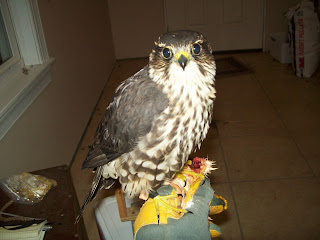
A lot of guys came down this weekend to trap. Two of them had the coveted peregrine tags. Arnaud and I wanted merlins, others were along for the ride. Some are still here - but Mother Nature was not cooperating.
We separated into three groups. Beachfront, soundfront, and mainland. We tried to spread ourselves out to figure out where the hawks were migrating. There just isn't any data for our state about exactly where the highest concentrations are flying.'
So, it was an experiment.
The guys arrived on Friday and checked out where they were going to be setting up their equipment.
Arnaud brought his merlin, so I was able to keep my eye on the prize. Then first thing Saturday morning we split up and went our separate ways.

Arnaud and I stayed in the mainland sight, waiting for the birds, but honestly, they were scarce. A coopers hawk here, a kestrel, etc.
Here is our sparrow bait strapped into a Millican harness, which worked very well. (thanks Johnathan)
The wind was out of the south, we rationalized that the birds weren't coming.
Bon showed up mid afternoon and took my spot, so I headed north and stayed with the boys on the soundside. now to be honest, they could see from one side of the beach to the other. Any bird in the sky, they should have been able to see it.
But the birds weren't there.

Sunday it rained and the wind blew at 20 - 30 miles an hour. We set up the beach site and tried all morning, but it was too miserable and there were no birds in the sky. We gave it a break, then tried again later when the rain had slackened. Merlins zoomed by, the wind carrying them past.
Nothing slowed for more than a second to look at our nets. And to be honest, the gusts were blowing them crazily, making them clearly visible.
The weekend was a bust.

I had taken Monday off - just in case. Everyone else set up along the beach, I opted for the mainland. I sat through the day and saw only one coopers. He came right to the pigeon, but landed behind the nets. I tried to scare him into the nets, but he flew off. And that was it.
I called it a day at 2:00. I packed up, knowing that my trapping chances were over. I was trying to come up with plan B. Maybe a kestrel?

Not sure.
On the way home I get a call from Arnaud on the north beach. They're seeing falcons and he's trapped a merlin.
After a few frantic phone calls, I change my plans, rearrange the kids ride schedules, then head north. There were a few hours of sunlight left.

I rode down the blowing sandy beaches, keeping to the ruts in front of me. I crossed the dune, and drove through the fields and past some local wildlife. I noticed none of it. I was frantic to get there.
When I got there Arnaud had trapped another bird, a male this time. he had figured out the secret to merlin trapping on the Outer Banks.
It was the merlin

tree. He set up behind it and it drew the birds in. weird.
By the time I left the trap site that night, there was another female merlin sitting on t

he seat next to me. She was trapped at 208 grams and is a gorgeous chocolate brown.
Still looking for a name.
and there are some guys still looking for their falcon.
I'll keep you posted.





































